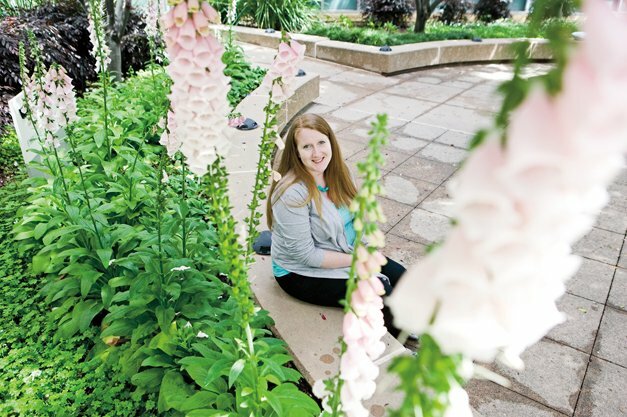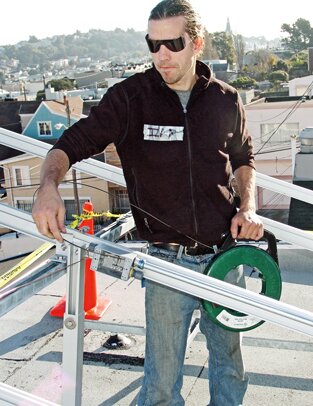SV2
Investors give money, time, and talent to worthwhile projects

SV2 executive director Lindsay Louie promotes philanthropy on a smaller, more personal scale. Below: Job Train student Ian Thomas pushes wire through conduit in preparation for the installation.
Photograph by Lane Johnson. Below: Photograph courtesy Job Train
In June of 2008, about 40 low-income young adults graduated from the Oakland Green Job Corps, a 16-week educational program that placed many of the students in full-time jobs with solar-energy firms and green construction contractors. Their starting wages were between $12 and $16 an hour.
The program was championed in part by the Oakland-based Ella Baker Center for Human Rights, which in 2008 received a $25,000 grant from the Silicon Valley Social Venture Fund, also known as SV2.
The grant helped develop and implement the Green Job Corps program, which has become a model for green-job training in California and across the country, says Abel Habtegeorgis, media relations manager for the Ella Baker Center. “If not for SV2, we couldn’t have been able to do that.”
Founded in 1998 by philanthropist and Stanford lecturer Laura Arrillaga-Andreessen, SV2 is a “venture philanthropy” fund that has awarded more than $3 million in grants to about 35 nonprofit organizations. Originally associated with what is now called the Silicon Valley Community Foundation, SV2 became an independent nonprofit in 2008.
The fund currently focuses on organizations working in the fields of environmental sustainability, education, and international development. In 2009, SV2 launched a teen philanthropy program for students in sixth through 12th grades who are the children or close relatives of SV2 investors.
Venture philanthropy accounts for just a small percentage of total philanthropy dollars nationwide, says Lindsay Louie, executive director of SV2. But SV2 provides more than money to the projects it funds. SV2 partner-investors offer their expertise as well, and often get highly involved in the organizations they’re donating to, sometimes even serving on their boards of directors. SV2 grantees get help with research and development, technology, marketing, and more.
“We do pro bono work for a lot of grantees in that respect,” says investor Ann Iverson, a San Carlos resident who works in marketing and communications in the energy efficiency industry.
SV2 investors are required to donate at least $5,000 a year. The returns they get include not only good feelings about doing good work, but also networking and learning opportunities.
SV2 partners hav e organized themselves into three “affinity groups” tackling specific subjects: education, international development, and the environment. The 15 to 20 partners that participate in the environmental affinity group, for example, decide collaboratively on what organizations they’re going to fund based on written materials and presentations by the non-profits, as well as site visits.
e organized themselves into three “affinity groups” tackling specific subjects: education, international development, and the environment. The 15 to 20 partners that participate in the environmental affinity group, for example, decide collaboratively on what organizations they’re going to fund based on written materials and presentations by the non-profits, as well as site visits.
In 2008, when the focus was on green jobs and green building, the environmental group split a $100,000 grant between three different organizations: Build It Green, the Ella Baker Center, and Menlo Park-based Job Train.
With SV2’s help, Berkeley-based Build It Green developed a Web-based program that allows cities to track how well green building practices are doing at mitigating the municipality’s carbon footprint.
“They were very involved throughout the process, checking in with us, giving us advice,” says David Myers, the manager of development and communications for Build It Green. “They were a fantastic group to work with.”
Brian Johnson, the program development manager for Job Train, says his organization now has green-oriented training courses focused on solar installation, weatherization, and green building. Job Train serves primarily low-income Peninsula residents.
SV2 provided funding to the organizations and brought them together with other nonprofits for a networking meeting.
“You get a little bit of funding and a lot of help,” Johnson says of SV2’s involvement. “They’re about helping you network and giving you advice as well.”
In the field of international development, SV2 recently made a three-year, $100,000 grant to Living Goods, which does work in Africa to support door-to-door sales in the Avon model. Salespeople sell items that promote disease prevention and general health, such as first aid kits, medicine, and mosquito nets.
SV2 continues to grow and may someday branch out in to other fields, such as health care or arts education.
“Lots of people, when they do hear about us and join us, say, ‘Why didn’t I know about this earlier? I would’ve joined years ago,’ ” says Holly Goodliffe, community relations manager for SV2. “We’re really trying to get the word out more. This is open to anyone who feels they’re a good fit for the organization and can make that $5,000 donation.”









